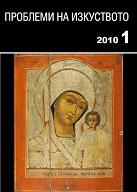Трансформации на постсоциалистическата живопис у нас през 90-те години на ХХ в. (някои паралели със западната, съветската и постсъветската живопис)
Transformations of Post-Socialist Painting in Bulgaria during the 1990s (Some Parallels with Western, Soviet and Post-Soviet Painting)
Author(s): Chavdar PopovSubject(s): Cultural history
Published by: Институт за изследване на изкуствата, Българска академия на науките
Summary/Abstract: In the post-socialist art scene, painting is just one of the many „media” in the complex and diverse panorama of artifacts, forms, manifestations, public gestures and behavior practices that can be legitimized with the term „art”. One tendency in post-socialist painting is connected with the use of image clichés, borrowed from the ideological myths and mass culture. This tendency is characteristic of postmodern painting, of pop-art and the so called „soc-art” that emerged in Soviet art round the second half of the 1970s. In the case of pop-art, deconstructed were the myths of consumer society and mass culture. In the case of the so called „soc-art” – the same was done with the social and political myths of the disintegrating communist society. In Bulgaria the imagery of socialism during the 1990 was replaced by a principally different imagery (the western type of mass media culture). Meanwhile on the other hand in the limelight come the individual programs, the personal „crea- tive mythologies” of the artists. In this sense there is only just a kind of diffusedly drawn ideological framework, a kind of hypothetically formed „community” of specific points of view, artistic ideas and orientations. Contrary to the „diver- sity” of the late-socialist painting, now we saw a specific principal difference of languages. In order to be able to speak about postmodernism as well as about soc-art, we have to admit that in the socialist art as well as in the Western art modernism had its specific place. In Bulgaria during the 1960-1980 its legitimization was realized indirectly mainly through the selective use and appropriation of native artistic heritage. The key possible resource for changes in those conditions was the national art fund – from the mediaeval and revival iconography through folklore and reaching up to the art of the 1930s. This was expressed in the elimination of the plot subject („illustrative”), in the activation of the color, the doing away with the third dimension, etc. The program of the, one may say „hidden modernism” of socialist art during the 1960-1980 rested on „innovation” to „overcome” the dogmas, norms, stereotypes, the idea of artistic progress. Processes of modernization took place also in soviet art in the framework of socialist realism. But after the socart emerged we could to a greater extent firmly speak about a parallel unfolding of some postmodernist trends that could be compared with the processes and tendencies in Western art. These processes, as this was partially the case in our country, during the 1980 mixed with „avant-garde” and „neo-avant-garde” trends.
Journal: Проблеми на изкуството
- Issue Year: 2010
- Issue No: 1
- Page Range: 42-47
- Page Count: 6
- Language: Bulgarian
- Content File-PDF

